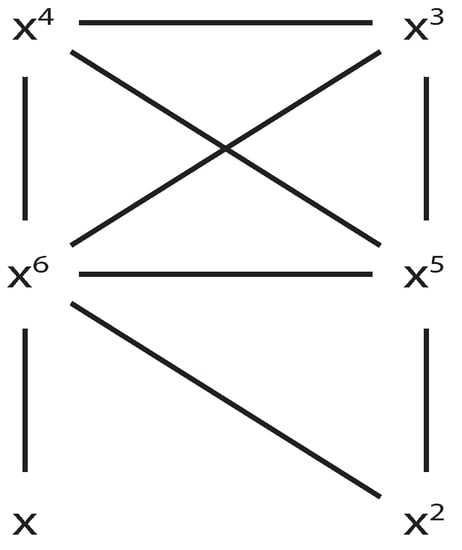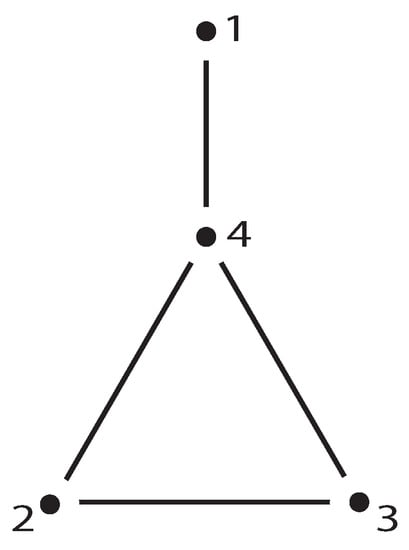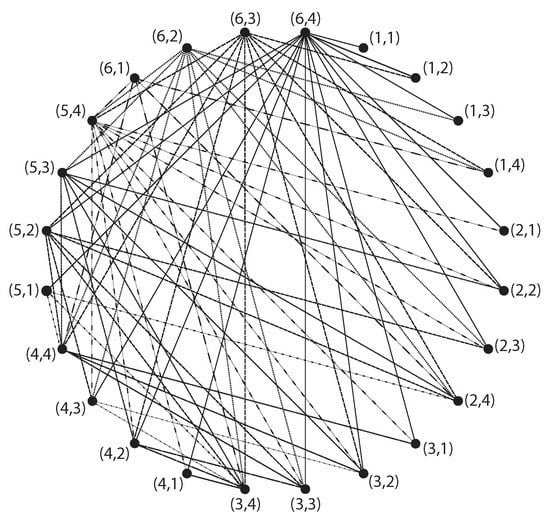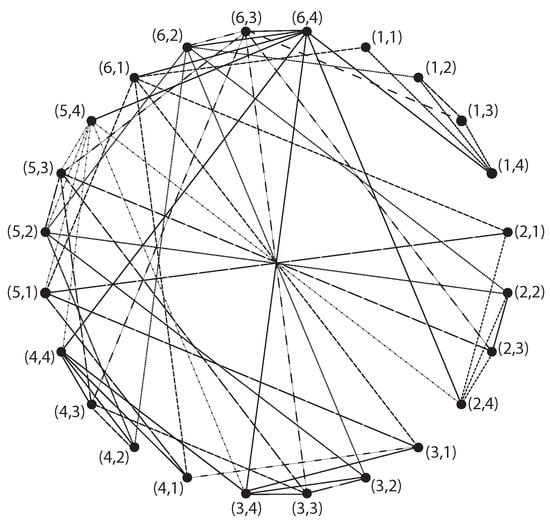Abstract
Consider a simple graph G with vertex set and edge set . A graph invariant for G is a number related to the structure of G, which is invariant under the symmetry of G. The Sombor index of G is a new graph invariant defined as . In this work, we connected the theory of the Sombor index with abstract algebra. We computed this topological index over the tensor and Cartesian products of a monogenic semigroup graph by presenting two different algorithms; the obtained results are illustrated by examples.
1. Introduction
Let be a simple graph with and as the vertex and the edge sets. The degree of a vertex will be indicated by . The edge adjacent to the vertices u and v will be specified by . In graph G, the distance between any two vertices u and v is stipulated by and is determined as the length of the shortest path linking u and v. For further information on the basics of graph theory, please see reference [].
A finite multiplicative monogenic semigroup (with zero) is given below
in which the authors put into effect in []. Whilst the graph is specified by modifying the adjacent rule of vertices and sticking to the original stance. The vertices of include all elements in , except zero. For any two different vertices, and in that are adjoined to one another, if and only if . For detailed information about monogenic semigroup graphs, see [,,].
Zero divisor graphs are the bases of monogenic semigroup graphs []. Zero divisor graphs were first conducted on commutative rings []; following this study, the researchers worked on commutative and non-commutative rings [,,]. Following the studies of zero divisor graphs on rings, in references [,], the authors utilized the information in commutative and noncommutative semigroups.
In chemistry, studies on topological indices have been carried out for more than half a century []. Recently, topological indices have been thoroughly detailed in mathematics. Indices such as these are utilised in creating structural properties of molecules, equipping us with data for industrial science, applied physics, biochemistry, environmental science, and toxicology []. In ref. [], Gutman introduced a graph-based topological index named the Sombor index. It was first used in chemistry [,,,,,]; soon after, it captured the attention of mathematicians [,,,,]. Network science used the modeling dynamical effect of biology and social technological complex systems []. The Sombor index became popular for military use as well []. Since its inception (less than one year after being published), the vast interest of mathematicians researching the Sombor index has been astounding. We believe that the Sombor index needs to be investigated in-more depth. Our research produces results based on the Sombor index category of algebraic structures, such as monogenic semigroups.
Graph operations play a pivotal role in mathematical chemistry due to the substantial importance they provide in evaluating numerous graph operations of simple graphs, such as chemical interest graphs. In addition, their importance, i.e., in the construction of bigger graphs out of smaller ones, is beneficial in the identification and decomposition of large graphs. Research into the extension of graphs is quintessential in applied sciences (see [,]). It is with this concept that the tensor and Cartesian products have been determined. The researchers in [,] estimated the Wiener index of the Cartesian product of graphs and in [] the authors calculated the Szeged index of the Cartesian product of graphs. In 2011, Yarahmadi calculated certain topological indices, such as the Zagreb indices and Harary and Schultz indices [].
In this paper, we use and as two simple graphs. The vertex set of the tensor product and Cartesian product of and are indicated by and , respectively. For the tensor product, necessary and sufficient conditions are applied for any in to be joined and . For the Cartesian product, necessary and sufficient conditions for any in to be associated is and or and .
In this study, the monogenic semigroup and monogenic semigroup were used, as given below, respectively,
The vertex set of the tensor product and the Cartesian product of and is given as:
The Sombor index invented by Gutman [] is a vertex degree-based topological index, which is narrowed down as
In addition, for a real number r, we designate by the greatest integer and by , the least integer . It is quite apparent that and . In addition, for a natural number n, we have
Here, any two vertices and are connected to each other if and only if
and
Our research calculates results based on the Sombor index of Cartesian and tensor products of monogenic semigroup graphs. Algorithms in Section 2 and Section 4 are given for the purpose of detecting vertex neighborhoods. With the help of these algorithms, the properties of the tensor and Cartesian products, respectively, will be used to calculate the Sombor indices on these products more easily. These algorithms are calculated independently of each other and the algorithm given in [] using tensor and Cartesian product definitions.
2. An Algorithm for the Tensor Product of the Monogenic Semigroup Graph
To make some simplifications in our calculations, we provide our results in Section 3 below; we present this algorithm on the neighborhood of the vertices on by considering the definition of the monogenic semigroup graph.
If m is even (n is even or odd):
: the vertex is linked to every vertex .
: the vertex is linked to every vertex .
: the vertex is linked to every vertex .
⋮
: the vertex is linked to every vertex .
: the vertex is linked to every vertex .
⋮
: the vertex is linked to .
By keeping these steps in this algorithm, we have two possibilities, depending on whether n is even or odd:
If m is odd and n is even:
: the vertex is linked to and .
If m is odd and n is odd:
: the vertex is linked to and .
In the following lemma, the vertex degrees are given as:
These vertex degrees are denoted by
Several investigations exist on the degree series with respect to this series; we referred to [,].
Lemma 1.
Remark 1.
Considering special observations in Lemma 1, the recurrent phrases utilized that follows
Consequently, the degree of is noted by , in spite of the amount of vertices by n.
3. Computing the Sombor Index of the Tensor Products of Monogenic Semigroup Graphs
Our data acquired in this area will produce an accurate formula of the Sombor index over the tensor products of monogenic semigroup graphs by using the above algorithm.
Theorem 1.
For any monogenic semigroup, and , the Sombor index over the tensor product of two monogenic semigroup graphs, , is
In the formula given above, , and will be taken in accordance with the rules and .
Proof.
Our primary focus was to methodically formulize concerning the sum of the degrees. The calculation includes the tally of several pieces, thereafter determining each separately. The calculation given in Section 2 is utilized and will determine the structures of the degrees of vertices. Equations (5), (10) and Remark 1 will allow us to evaluate further.
If m and n is even:
Consequently the Sombor index is noted as the sum following
Whilst estimating the Sombor index value, the minutest amount is acquired after several calculations. Where n is odd, we utilize the equality given in (5). Then we obtain
The above equation can be given briefly with the sum symbol as follows
If similar operations in are applied to
, we obtain
If it continues in this way, the following equalities will be obtained for , , and , respectively,
and
In this way, , ,…, , …, , , …, are calculated one-by-one to obtain a general sum formula as given below:
□
4. An Algorithm for the Cartesian Product of the Monogenic Semigroup Graph
We introduced this algorithm to the neighborhood of the vertices on , taking into consideration the details of the monogenic semigroup graphs. Our main results will be presented in Section 5 with our calculations.
If m is even (n is even or odd):
: the vertex is linked to and .
: the vertex is linked to and .
: the vertex is linked to and .
⋮
: the vertex is linked to .
: the vertex is linked to and .
⋮
: The vertex is linked to .
By continuing these steps, if m is odd, the following situation will occur depending on whether n is even or odd.
If m is odd (n is even or odd):
: the vertex is linked to .
5. Computing the Sombor Index of the Cartesian Products of Monogenic Semigroup Graphs
In this section, by using the above algorithm, the formula of the Sombor index of the Cartesian products of the monogenic semigroup graphs will be given.
Theorem 2.
For any monogenic semigroup, and , the Sombor index over the Cartesian products of two monogenic semigroup graphs is
In the formula given above, , and will be taken in accordance with the rules , and , .
Proof.
Since our primary focus is to formulize concerning the total number of degrees, we need to treat the sum as the sum of the total amount of different blocks, thereafter determined individually. The calculation given in Section 2 is utilized and will determine the structures of the degrees of vertices with the addition of Equations (5), (10), and Remark 1.
If m and n are even:
Consequently, the Sombor index of is stated as the sum below
Whilst estimating the Sombor index value, the minutest amount is acquired after several calculations. Where n is odd, we utilize the equality given in (5). Then we have
The above equation can be given briefly with the sum as follows
If similar operations applied in are applied to
, we obtain
If it is continued in this way, the following equalities are obtained for
, and , respectively,
and
In this way, , ,…,
, …, , , …, are calculated one-by-one to obtain a general sum formula as given below:
□
The examples given below show the calculation of the Sombor index of the tensor product and Cartesian product of and , to support the main theorems.
Example 1.
Let and be a monogenic semigroup that is given in the following:
Now we will calculate the Sombor index of the graph by using the technique given in Theorem 1.
By using the formula, which is given in the following
we obtain
Example 2.




The Cartesian products of the graphs and are given below. By using the formula given in Theorem 2, we will calculate the Sombor index of .
By utilizing the formula given as
we have
As we understand, the Sombor index of a graph of tensor and Cartesian products, of two monogenic semigroups, are easily found by considering the exact formula obtained in the main theorems (Figure 1, Figure 2, Figure 3 and Figure 4).

Figure 1.
monogenic semigroup graph.

Figure 2.
monogenic semigroup graph.

Figure 3.
Tensor products of and monogenic semigroup graphs.

Figure 4.
Cartesian products of and , monogenic semigroup graphs.
6. Conclusions
In the mathematical and chemical literature, there are so-called vertex-degree-based topological indices. One of the newest vertex-degree-based indices is the Sombor index; it soon became very popular, with around 100 published papers. The Sombor index differs from earlier vertex-degree-based topological indices because it has a peculiar geometric interpretation. Extending the theory of the Sombor index beyond classical combinatorics and linear algebra is of great importance, as it confirms that the Sombor index concept is not just one of the numerous vertex-degree-based graph invariants, but it has a deeper geometry-related meaning (as shown in []). Numerous research papers on the Sombor index and its variants have applied methods involving standard combinatorial optimization or linear algebra. In this work and in [] we used the Sombor index in the semigroup theory as an exception. We connected the Sombor index with abstract algebra. In particular, we computed this index over the tensor and Cartesian products of a monogenic semigroup graph; the obtained results are supported by examples. To better comprehend the Sombor index, see []. Calculating the Sombor index (of disjunctive and corona products) over a graph of a monogenic semigroup remains an open problem.
Funding
This research received no external funding.
Institutional Review Board Statement
Not applicable.
Informed Consent Statement
Not applicable.
Data Availability Statement
Not applicable.
Conflicts of Interest
The author declares no conflict of interest.
References
- West, D.B. An Introduction to Graph Theory; Prentice-Hall: Upper Saddle River, NJ, USA, 1996. [Google Scholar]
- Das, K.C.; Çevik, A.S.; Cangül, I.N.; Shang, Y. On Sombor index. Symmetry 2021, 13, 140. [Google Scholar] [CrossRef]
- Akgüneş, N.; Das, K.C.; Çevik, A.S. Topological Indices on a Graph of Monogenic Semigroups; Gutman, I., Ed.; Topics in Chemical Graph Theory, Mathematical Chemistry Monographs; University of Kragujevac and Faculty of Science Kragujevac: Kragujevac, Serbia, 2014. [Google Scholar]
- Akgüneş, N.; Çağan, B. On the dot product of graphs over monogenic semigroups. Appl. Math. Comput. 2018, 322, 1–5. [Google Scholar] [CrossRef]
- Akgüneş, N. A further note on the graph of monogenic semigroups. Konuralp J. Math. 2018, 6, 49–53. [Google Scholar]
- Beck, I. Coloring of Commutating Rings. J. Algebra 1988, 116, 208–226. [Google Scholar] [CrossRef]
- Anderson, D.D.; Naseer, M. Beck’s coloring of a commutative ring. J. Algebra 1991, 159, 500–514. [Google Scholar] [CrossRef] [Green Version]
- Anderson, D.F.; Livingston, P. The Zero-divisor Graph of Commutative Ring. J. Algebra 1999, 217, 434–447. [Google Scholar] [CrossRef] [Green Version]
- Anderson, D.F.; Badawi, A. On the Zero-Divisor Graph of a Ring. Commun. Algebra 2008, 36, 3073–3092. [Google Scholar] [CrossRef]
- DeMeyer, F.R.; DeMeyer, L. Zero-Divisor Graphs of Semigroups. J. Algebra 2005, 283, 190–198. [Google Scholar] [CrossRef] [Green Version]
- DeMeyer, F.R.; McKenzie, T.; Schneider, K. The Zero-Divisor Graph of a Commutative Semigroup. Semigroup Forum 2002, 65, 206–214. [Google Scholar] [CrossRef]
- Todeschini, R.; Consonni, V. Molecular Descriptors for Chemoinformatics; Wiley VCH: Weinheim, Germany, 2009. [Google Scholar]
- Devillers, J.; Balaban, A.T. Topological Indices and Related Descriptors in QSAR and QSPR; Gordon and Breach: Amsterdam, NY, USA, 1999. [Google Scholar]
- Gutman, I. Geometric approach to degree-based topological indices: Sombor indices. MATCH Commun. Math. Comput. Chem. 2021, 86, 11–16. [Google Scholar]
- Alikhani, S.; Ghanbari, N. Sombor index of polymers. MATCH Commun. Math. Comput. Chem. 2021, 86, 715–728. [Google Scholar]
- Amin, S.; Rehman Virk, A.U.; Rehman, M.A.; Shah, N.A. Analysis of dendrimer generation by Sombor indices. J. Chem. 2021, 2021, 9930645. [Google Scholar] [CrossRef]
- Cruz, R.; Gutman, I.; Rada, J. Sombor index of chemical graphs. Appl. Math. Comput. 2021, 399, 126018. [Google Scholar] [CrossRef]
- Liu, H.; You, L.; Huang, Y. Ordering chemical graphs by Sombor indices and its applications. MATCH Commun. Math. Comput. Chem. 2022, 87, 5–22. [Google Scholar] [CrossRef]
- Liu, H.; Gutman, I.; You, L.; Huang, Y. Sombor index: Review of extremal results and bounds. J. Math. Chem. 2022, 66, 771–798. [Google Scholar] [CrossRef]
- Redžepović, I. Chemical applicability of Sombor indices. J. Serb. Chem. Soc. 2021, 86, 445–457. [Google Scholar] [CrossRef]
- Horoldagva, B.; Xu, C. On Sombor index of graphs. MATCH Commun. Math. Comput. Chem. 2021, 86, 713–793. [Google Scholar]
- Milovanovic, I.; Milovanovic, E.; Ali, A.; Matejic, M. Some results on the Sombor indices of graphs. Contrib. Math. 2021, 3, 59–67. [Google Scholar]
- Oğuz Ünal, S. An application of Sombor index over a special class of semigroup graph. J. Math. 2021, 2021, 3273117. [Google Scholar] [CrossRef]
- Rada, J.; Rodríguez, J.M.; Sigarreta, J.M. General properties on Sombor indices. Discrete Appl. Math. 2021, 299, 87–97. [Google Scholar] [CrossRef]
- Shang, Y. Sombor index and degree-related properties of simplicial networks. Appl. Math. Comput. 2022, 419, 126881. [Google Scholar] [CrossRef]
- Gutman, I. Spectrum and energy of the Sombor matrix. Mil. Tech. Cour. 2021, 69, 551–561. [Google Scholar] [CrossRef]
- Imrich, W. Factoring cardinal product graphs in polynomial time: Discrete metric spaces. Discrete. Math. 1998, 192, 119–144. [Google Scholar] [CrossRef] [Green Version]
- Imrich, W.; Klavzar, S. Product Graphs: Structure and Recognition, Wiley-Interscience Series in Discrete Mathematics and Optimization; Wiley-Interscience: New York, NY, USA, 2000; p. xvi+358. [Google Scholar]
- Graovac, A.; Pisanski, T. On the Wiener index of a graph. J. Math. Chem. 1991, 8, 53–62. [Google Scholar] [CrossRef]
- Yeh, Y.N.; Gutman, I. On the sum of all distances in composite graphs. Discrete Math. 1994, 135, 359–365. [Google Scholar] [CrossRef] [Green Version]
- Klavzar, S.; Rajapakse, A.; Gutman, I. The Szeged and the Wiener index of graphs. Appl. Math. Lett. 1996, 9, 45–49. [Google Scholar] [CrossRef] [Green Version]
- Yarahmadi, Z. Computing some topological indices of tensor product of graphs. Iran. J. Math. Chem. 2011, 2, 109–118. [Google Scholar]
- Akgüneş, N.; Çevik, A.S. A new bound of radius of irregularity index. Appl. Math. Comput. 2013, 219, 5750–5753. [Google Scholar] [CrossRef]
- Das, K.C.; Akgüneş, N.; Çevik, A.S. On a graph of monogenic semigroup. J. Ineq. Appl. 2013, 2013, 44. [Google Scholar] [CrossRef] [Green Version]
Publisher’s Note: MDPI stays neutral with regard to jurisdictional claims in published maps and institutional affiliations. |
© 2022 by the author. Licensee MDPI, Basel, Switzerland. This article is an open access article distributed under the terms and conditions of the Creative Commons Attribution (CC BY) license (https://creativecommons.org/licenses/by/4.0/).